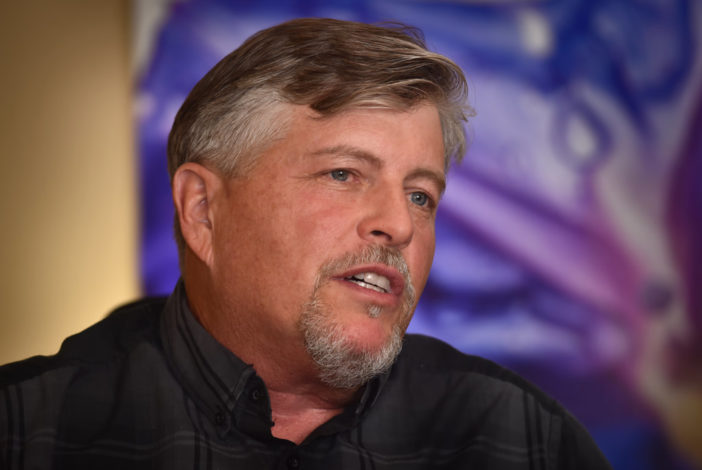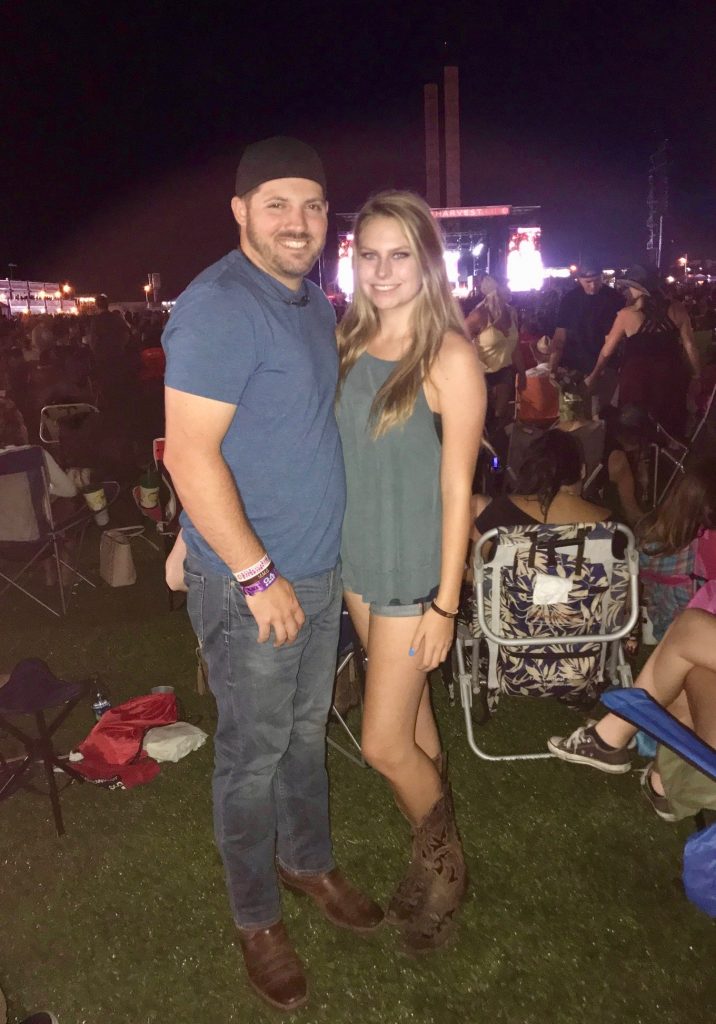In his 35-year career as a photojournalist, 24 years at the Orange County Register, Bruce Chambers captured countless scenes of horror.
And often, the trauma he witnessed became too much.
He recalls a photo editor asking him one day to cover a child’s funeral.
“No,” Chambers said.
“Why not?”
“Because I shot the last five.”
Now, as a licensed marriage and family therapist in Brea, Chambers trains his eyes at people mired in interpersonal trauma. He specializes in “infidelity recovery,” counseling people torn apart by marital affairs.
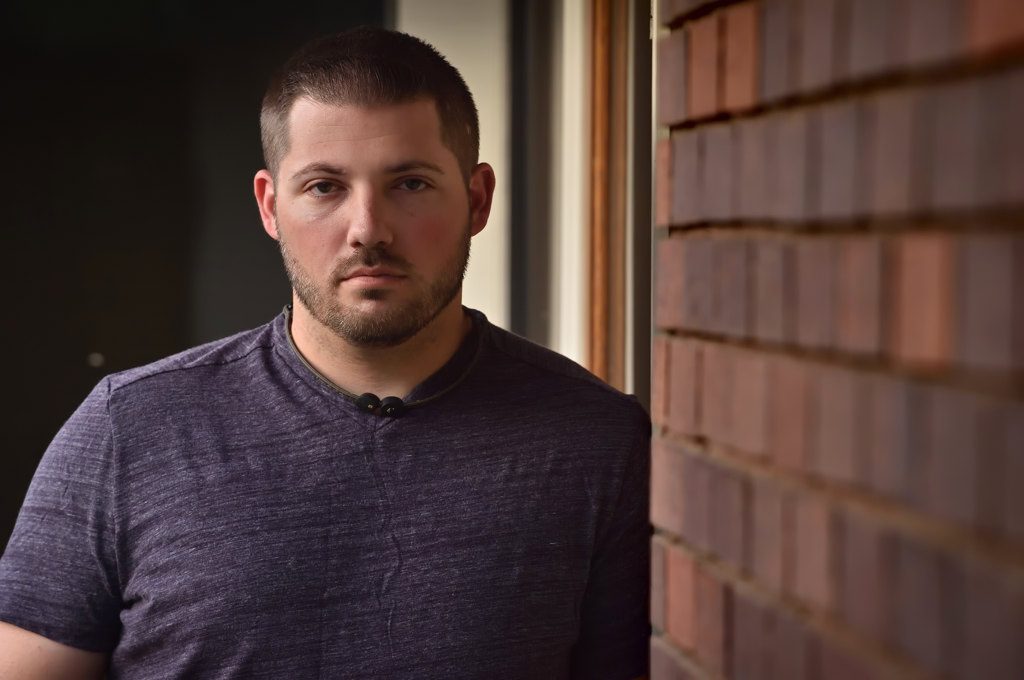
Tony Miranda of Placentia was close to the stage during the Route 91 Harvest music festival when the shooting broke out. He has taken advantage of free group counseling offered by Orange-based Center for Individual & Family Therapy.
Photo by Steven Georges/Behind the Badge OC
Since Oct. 2, Chambers has been running free 90-minute group therapy sessions for Las Vegas shooting survivors under the auspices of his employer, the Center for Individual & Family Therapy.
One survivor, Tony Miranda — who saw 15 to 20 people shot on Oct. 1, and who carried or guided three of the wounded into a police car — has been to three of Chambers’ sessions, two at his Brea office and one at his home in Placentia, where Chambers’ wife, Carole, served homemade chili and hot dogs to traumatized attendees.
On Thursday, Oct. 12 — 11 days after the massacre that claimed the lives of 58 concertgoers — Miranda was shopping with his mother at a Walmart when loud sounds startled him.
He lost it.
The 28-year-old began sobbing. Then he and his mother left the store.
Turns out some crates had fallen off a shelf.
For Miranda, the crashing didn’t exactly sound like gunshots.
But close enough.
“My mind went right back to that night,” he said.
***
Chambers, 60, went to bed “that night” knowing lots of people had died in the shooting.
He had a full day ahead of him Monday, Oct. 2., with clients from 10 a.m. through the early evening.
In the past, he and his wife, a speech pathologist, have donated money to victims of tragedies, including the recent floods in Houston.
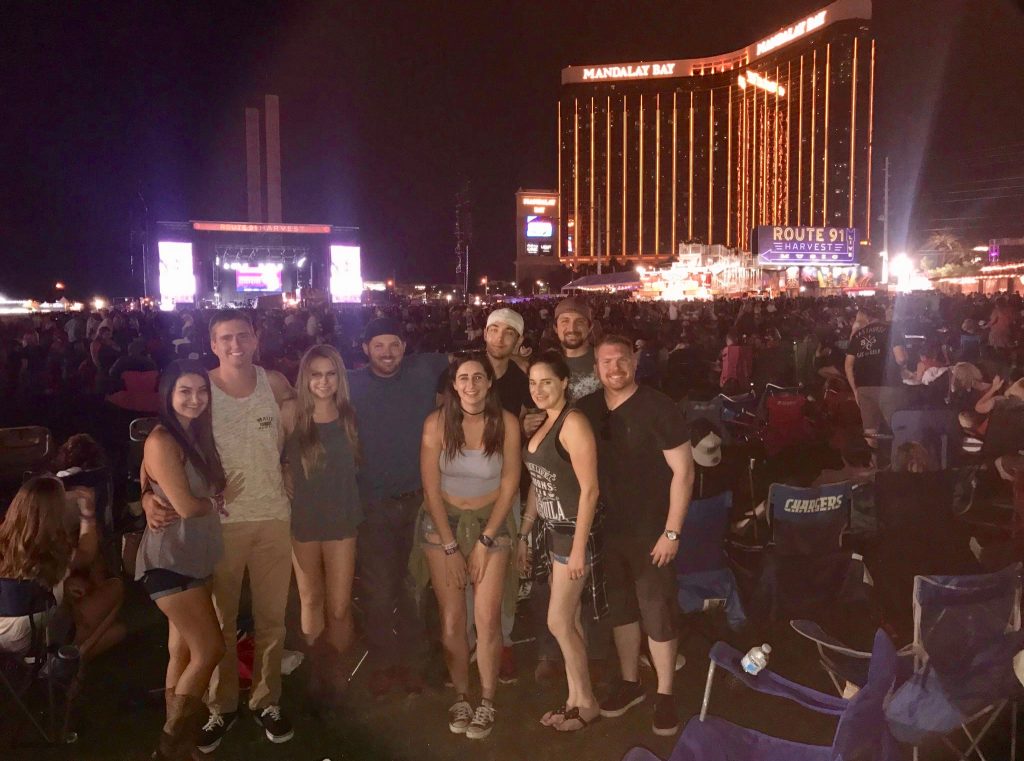
This photo was taken about 30 minutes before the shots rang out and before Tony Miranda (fourth from left) and his friends decided to move close to the stage. Photo courtesy of Tony Miranda
“I went through the whole day thinking, ‘What are we going to do about this?’” Chambers said.
Carole Chambers heard about a therapist who was offering free counseling to people who witnessed the carnage in Vegas, and she told her husband about it.
“That’s a great idea,” Bruce told her.
During his days at the OC Register — Chambers left the newspaper in Summer 2014, during a wave of buyouts as the paper struggled financially — the photographer perhaps best known for his work on the busy and often grisly breaking-news beat often felt he wanted to do more for the victims he photographed, but couldn’t.
He would try to calm down many of his story subjects. Often, he left scenes with a nagging sense of helplessness.
“I never felt like I was able to give them enough,” Chambers says.
Now, as a therapist, he was in a position to do just that.
***
None of the eight people Miranda went with to the concert — including his girlfriend, younger brother and best friend — to celebrate his birthday were physically hurt.
Emotionally, however, is a different story.
“I’ve always been one to keep a level head,” says Miranda, a personal banker at Wells Fargo and former Eagle Scout and lifeguard at an amusement center. “I’m a logical thinker, and I’ve always been someone who likes to help people.”
Which explains how he was able to keep a relatively cool head during and after the shooting to protect his girlfriend and attend to many of the wounded, including a woman who got shot in the hip.
Miranda, a county music fanatic who line dances two to three times a week, tore off his T-shirt and applied pressure to her wound.
“I don’t want to die!” she kept screaming.
Miranda doesn’t recall her name, just that it begins with a J.
After carrying the woman and placing her in an empty Las Vegas Metropolitan PD patrol car, Miranda noticed a “dazed” woman stumbling around.
When she turned toward Miranda, he saw an entry wound in her left cheek and the right side of her face blown open.
He got that woman into the car, too, along with a man shot in the foot, and ordered a young police officer who approached the car to take the wounded to the hospital.
“I didn’t allow my emotions to hit,” Miranda says, “because I was the strong one.”
The next morning, however, Miranda broke down when he walked out of his hotel into the eerie calm and saw all the blood and debris.
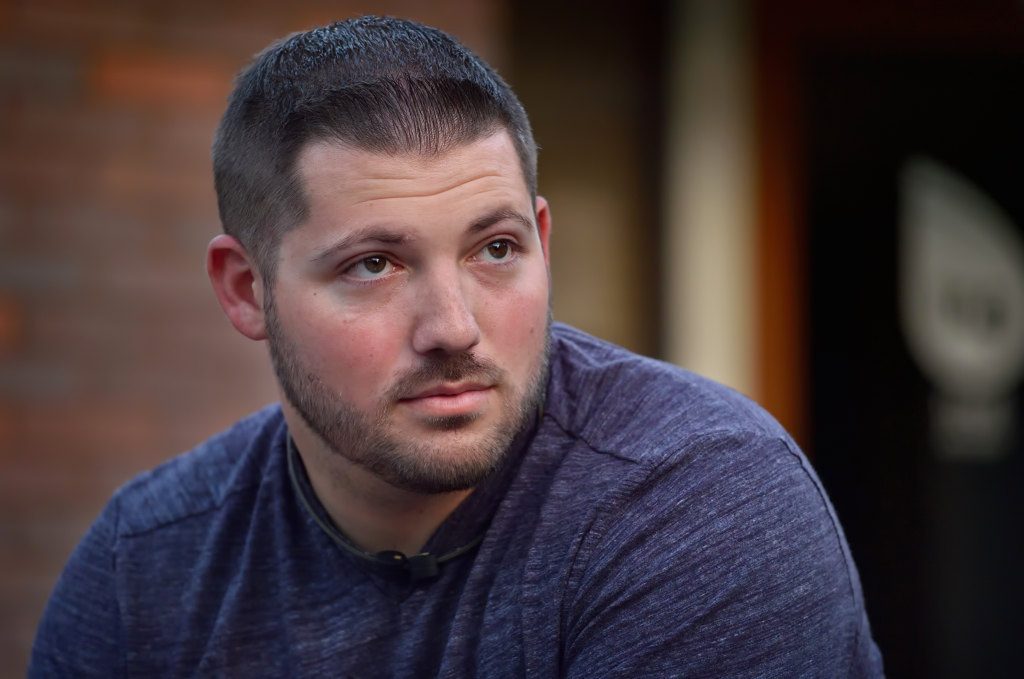
Vegas shooting survivor Tony Miranda: “We don’t feel normal. None of us do.”
Photo by Steven Georges/Behind the Badge OC
On Tuesday, Oct. 3, he went to work to tell his bosses he wouldn’t be coming to work.
His parents, who have known Bruce and Carole Chambers for years, heard about the free group therapy sessions and urged him to go.
All but two of the eight people who were at the concert with Miranda attended the second of Chambers’ sessions, on Wed., Oct. 4.
A total of 20 survivors went that night, divided into two offices.
Ten were in Chambers’ office, which has muted lighting and is brightened by some of his nature photography, including a high-definition close-up of a morning glory blossom that looms above his desk.
***
The Center for Individual & Family Therapy, with offices in Brea, Orange, Los Alamitos, Costa Mesa and Torrance, bills itself as Southern California’s largest Christian counseling center, with a total of 50 therapists.
The goal of the group sessions for the Las Vegas concertgoers is to get them to normalize their experiences, to identify healthy and unhealthy emotions, to provide resource information, and to create a safe space to be with other survivors who shared the experience.
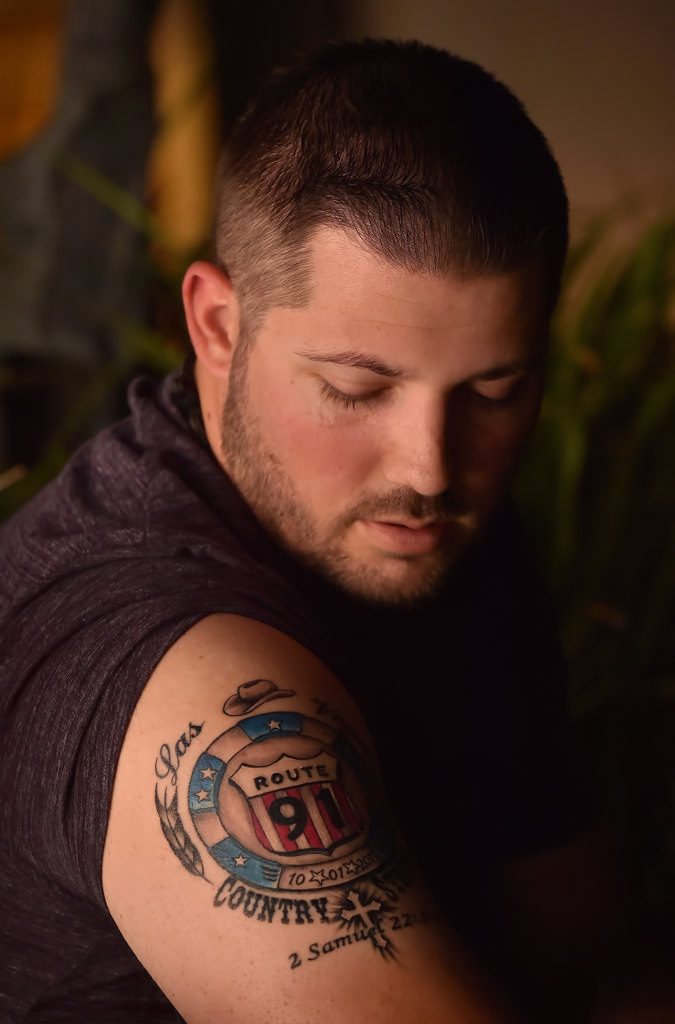
Tony Miranda shows a tattoo he recently got to memorialize the tragedy and those who didn’t make it.
Photo by Steven Georges/Behind the Badge OC
“Think about it,” says Chambers, who earned a master’s degree in 2013 while still working at the OC Register after realizing he needed a backup employment plan as the newspaper industry nosedived.
“There were 22,000 people experiencing a moment of joy who were instantly shoved into a war zone,” he says. “And 99.9 percent of them had no experience with this kind of trauma, or were not trained to run into danger.”
People just like Miranda, who felt an agonizing sense of guilt, one of the most common emotion survivors feel, says Chambers.
In Miranda’s case, he felt guilty because he couldn’t help or save more people.
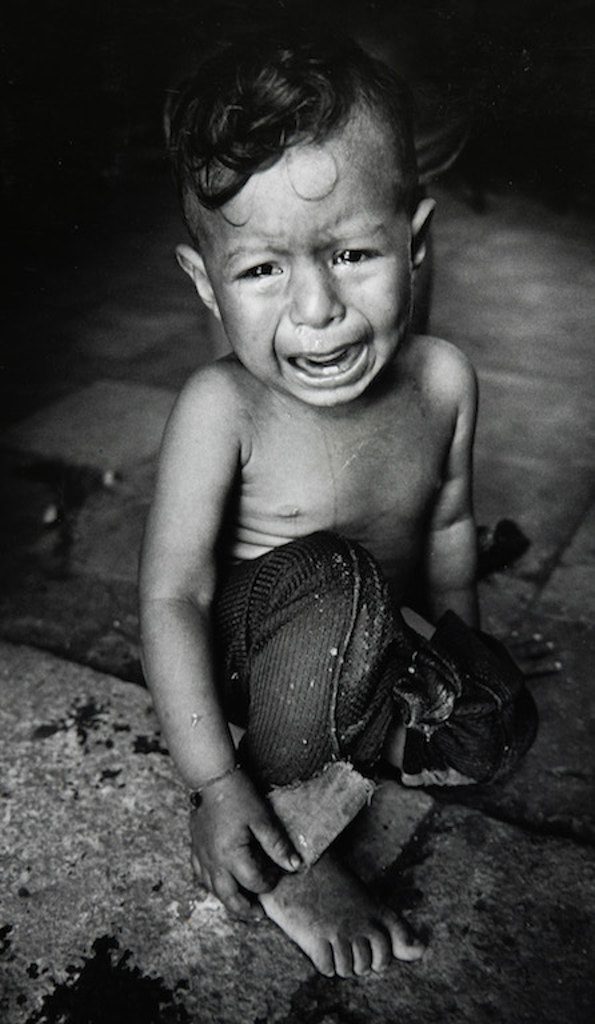
A scared and homeless child cries after fleeing the violence of war in Southern Honduras. Members of a village had fled their homes near the Honduran and Nicaraguan border during clashes between the Contra and Sandinista armies in 1983. Photographer Bruce Chambers was on assignment for the Tucson Citizen to document the plight of Central American refugees.
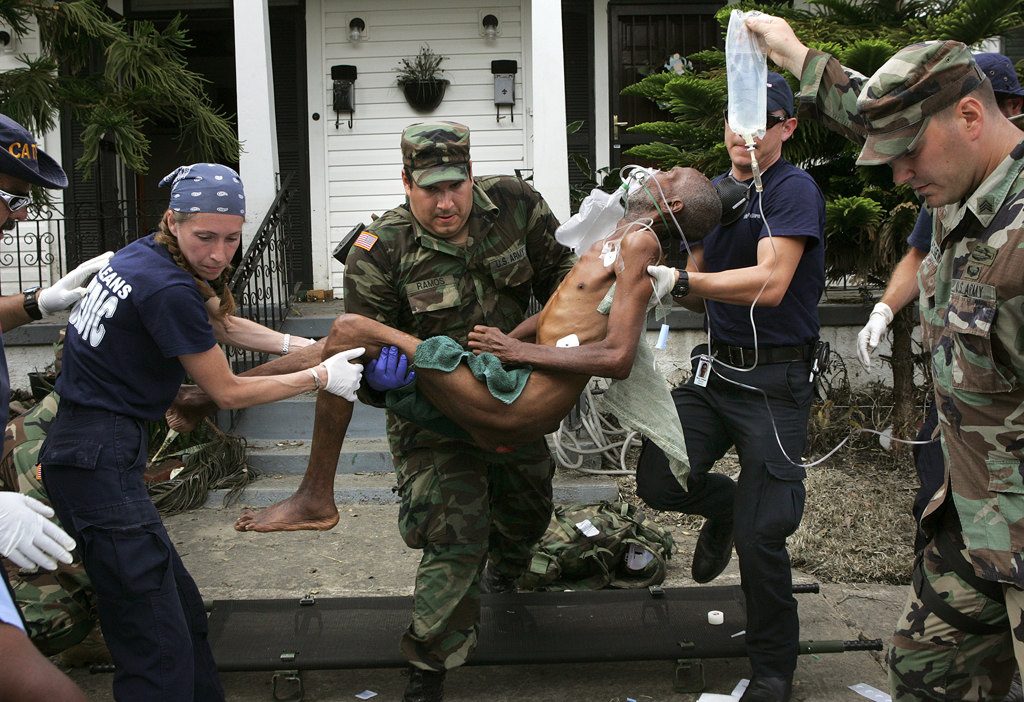
In this photo taken Sept. 13, 2005, first responders lift Edgar Hollingsworth, 74, onto an ambulance gurney in front of his home after Hurricane Katrina ravaged New Orleans. He died two days later. Orange County Register photo by Bruce Chambers
“People felt different kinds of guilt,” says Chambers. “Some felt guilty because they ran past the injured or dead. One woman felt guilty for taking her bridal party to Vegas when Palm Springs had been on the table. One guy felt guilty he didn’t feel as traumatized as the others because he was blocks away from the shooting eating at a restaurant.”
One of the most important components of the therapy sessions, says Chambers, is validating everyone’s feelings. There’s no right or wrong emotion to feel after experiencing such a traumatic event, he says.
Chambers describes the group sessions as triage therapy.
“We trying to identify how people are coping and who needs the most help,” he says.
***
Miranda went on medical leave for more than a week and was back to work Friday, Oct. 13.
But things are anything but routine, he says.

A member of the Orange County Sheriff’s Department digs through the rubble of the Cerritos plane crash, looking for human remains. The midair collision, on Sunday, Aug. 31, 1986 occurred when Aeroméxico Flight 498, a McDonnell-Douglas DC-9, was clipped by a Piper PA-28-181 Archer while descending into Los Angeles International Airport, killing all 67 people on both aircraft and an additional 15 people on the ground. Photo by Bruce Chambers
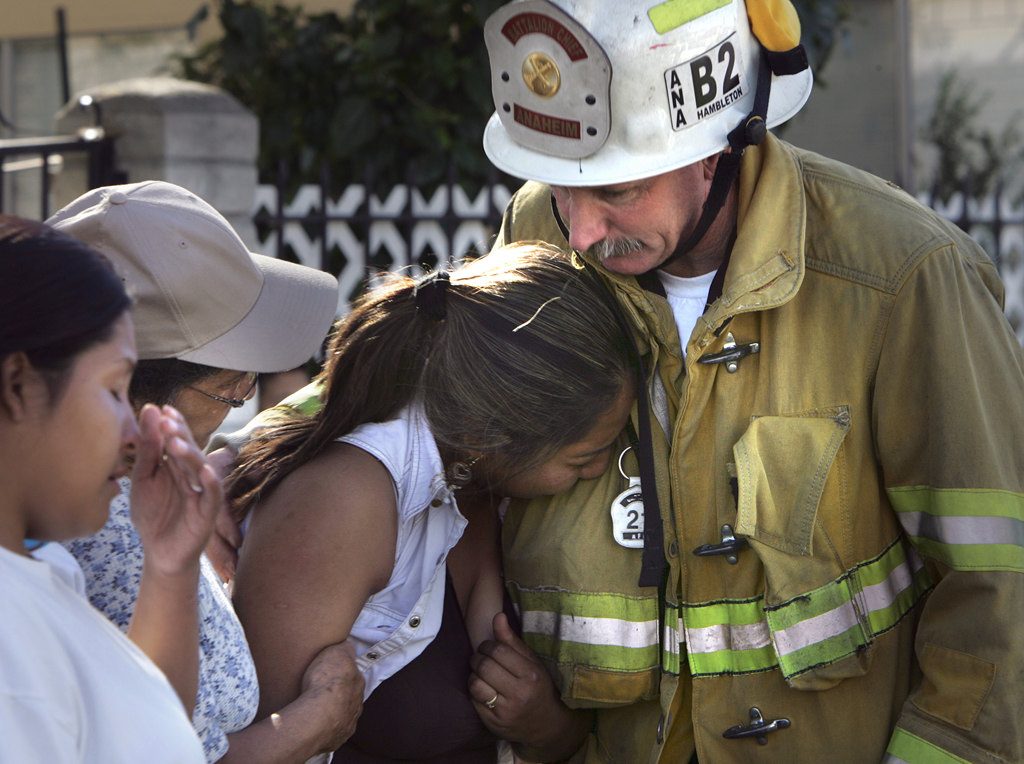
In this photo taken Feb. 13, 2006, Anaheim Fire Department Battalion Chief Dennis Hambleton consoles a distraught woman whose home in West Anaheim burned down. Orange County Register photo by Bruce Chambers
“We don’t feel normal. None of us do.”
Some friends of survivors don’t seem to care what they’re going through, Miranda says.
Some just seem to want gory details.
Some survivors are having a hard time with co-workers giving them hugs, constantly asking if they’re OK.
“Some of us just want to be left alone,” Miranda says.
Miranda says he continues to feel spooked in large groups of people. And he hates the sounds of sirens and helicopters and other loud noises.
He continues to experience “night terrors,” waking up in a sweaty panic.

On his first visit back to Phnom Penh, in 1989, after the genocide of the Khmer Rouge, Chantara Nop wipes tears as he views thousands of skulls unearthed in the Killing Fields of Cambodia. Nop, who escaped Cambodia to reestablish his life in Long Beach, realized that any one of these skulls could belong to his family members killed in the genocide. Photo by Bruce Chambers
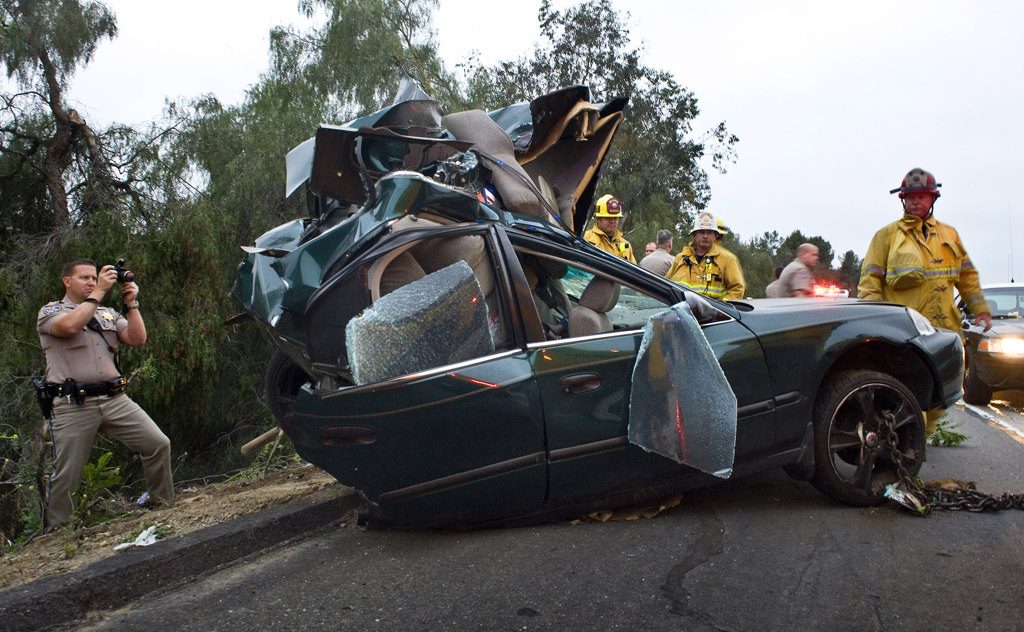
In this photo taken May 6, 2010, a female driver died in a wreck of her Honda Civic as it skid off the southbound 57 Freeway and into a tree just north of Yorba Linda Boulevard. Orange County Register photo by Bruce Chambers
Chambers has hosted a half-dozen group therapy session for the Vegas concertgoers, aided by fellow CIFT therapists Jacqueline Mack-Harris and Rachael Witherspoon.
The next one is Tuesday, Oct. 24, at his Brea office.
Miranda says the 90-minute sessions have been invaluable.
“I can’t thank him enough for what he’s doing for us,” Miranda says. “It’s helped, because he makes us feel normal when everyone else is looking at us like we’re damaged. A lot of people are still looking at me like I’m broke and they want to fix me. I want nothing more than to go back to the way things used to be.”
Miranda and other survivors talk to each other on several private social media sites.
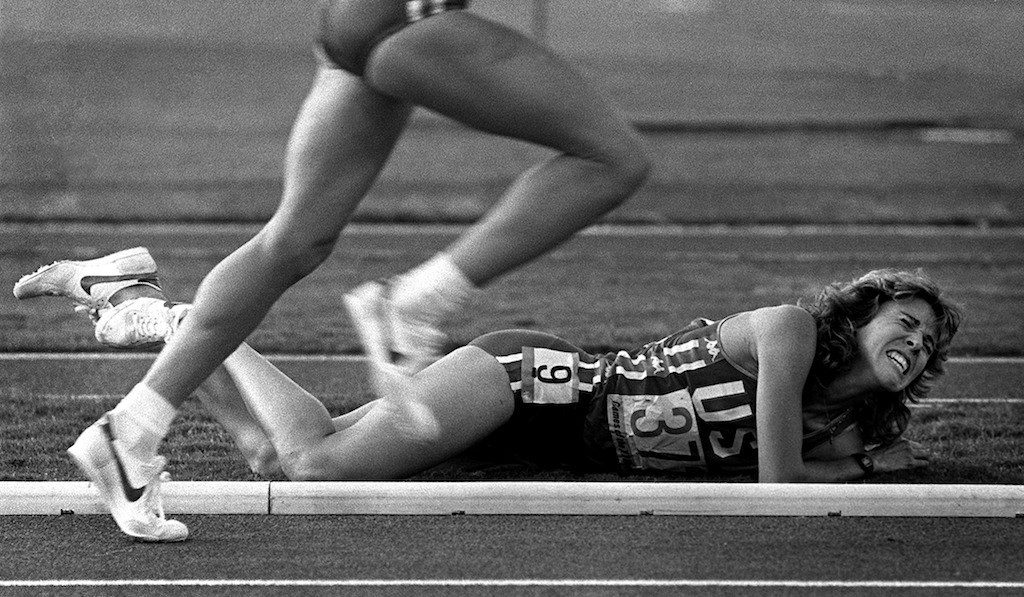
At the Los Angeles Coliseum running track, long-distance runner Mary Decker writhes in pain after colliding with British (South African) runner Zola Budd during the 3000 meters race at the 1984 Olympics. The two were set up for a famous race: American darling Decker trying to win an Olympic Gold medal after years of difficulties and disappointments versus the controversial Zola Budd, a barefoot-running teenager who grew up in South Africa and bent the Olympic rules to compete for Britain, because South Africa was banned from the Games due to their apartheid policy. When the two tangled coming out of a corner on the track, Decker fell onto the infield, injuring herself and ruining her chance at medaling, let alone finishing. Photo by Bruce Chambers

In this photo from January 2011, parents comfort their children at the site where an 8-year-old boy riding his bike to school was struck and killed by an SUV. Orange County Register photo by Bruce Chambers
Many, like him, have gotten tattoos to memorialize their experience. They feel they belong to a special club none asked to join.
Some people have asked Miranda, Why would you want to have a permanent reminder of such a tragedy?
“I never want to forget what happened,” he says. “I want to always celebrate the gift of walking away from it. I’ve been marked emotionally forever, but people aren’t going to be able to see that. This will allow them to see.”
Miranda is asked about the shooter.
“A lot of people want a motive, but I don’t,” he says. “I think it’s just a way for people to put hate somewhere else. Our country has enough issues. I don’t think we need anything more to find hate in. I’m fine with the hate dying with him.”
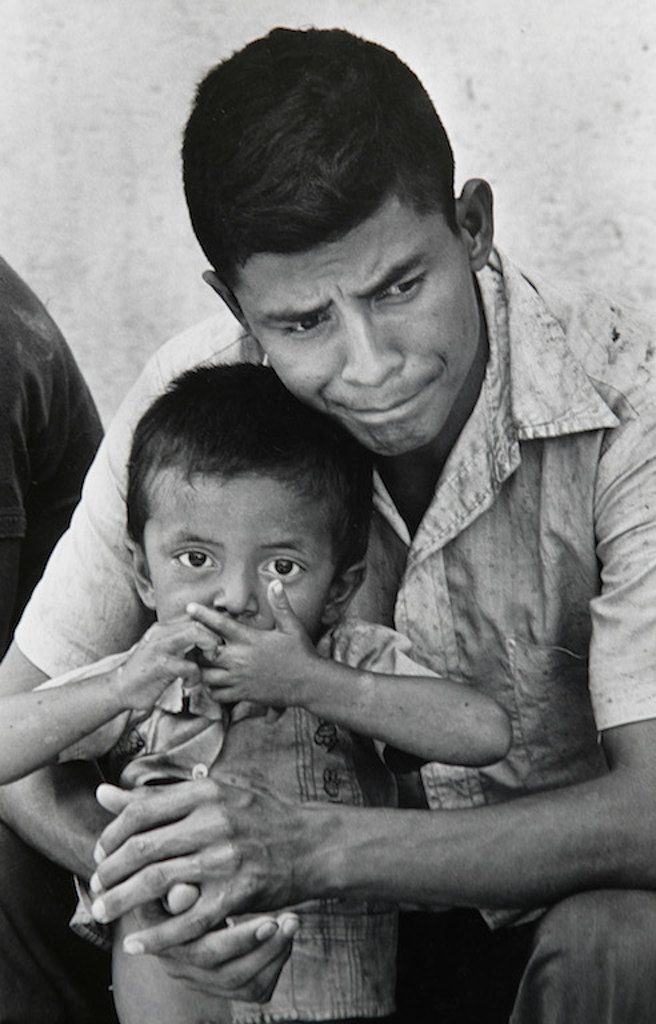
In a small village of Southern Honduras, a father ponders his future while holding his son. In the summer of 1983, his family and neighbors had fled the violence of the Contra War along the Honduras/Nicaragua border. They were now homeless and had no belongings, refugees of a war they had no part in. Photo by Bruce Chambers
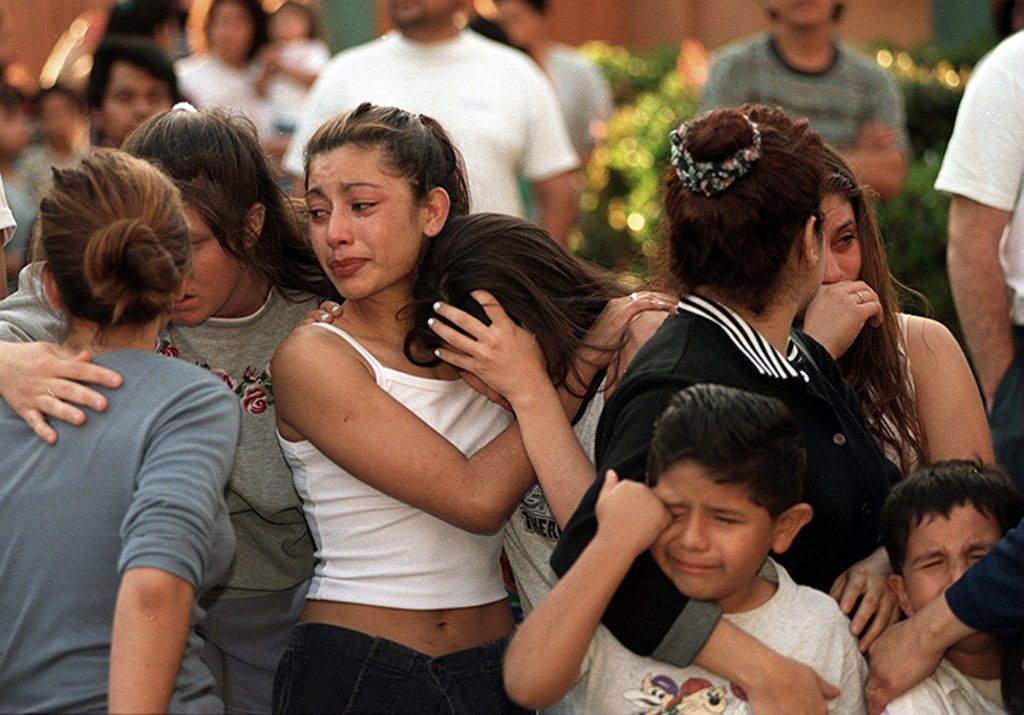
In this photo taken March 31, 1997, residents console each other outside the 1700 block of Temple Street near Orangethorpe Avenue in Anaheim after an apartment blaze destroyed the two-story complex. Orange County Register photo by Bruce Chambers
Chambers, a community pastor at VOX Community, a Christian group that meets every Sunday at El Dorado Performing Arts Center in Placentia, has told many survivors they had the proper reaction: save themselves.
“I’ve told some of them, ‘If you escaped this horrible tragedy to live another day, to love on your family and friends, then you are a hero in my eyes.’
“I’ve told them, ‘Once you process the trauma and sadness of it, and grieve your losses, this is also an opportunity for you to make a better life. Maybe you’ll have a spiritual awakening. Maybe you’ll start making the best of each day.
“‘It doesn’t have to be a complete negative for the rest of your life.’”
CIFT is working on plans for long-term care for Las Vegas shooting survivors that need it. Many other agencies and individual therapists also are still providing services. Call CIFT’s main office at 714-558-9266 for information.
Click here to read one expert’s take on common reactions to trauma.
Click here for one Facebook support group for survivors.
 Behind the Badge
Behind the Badge
